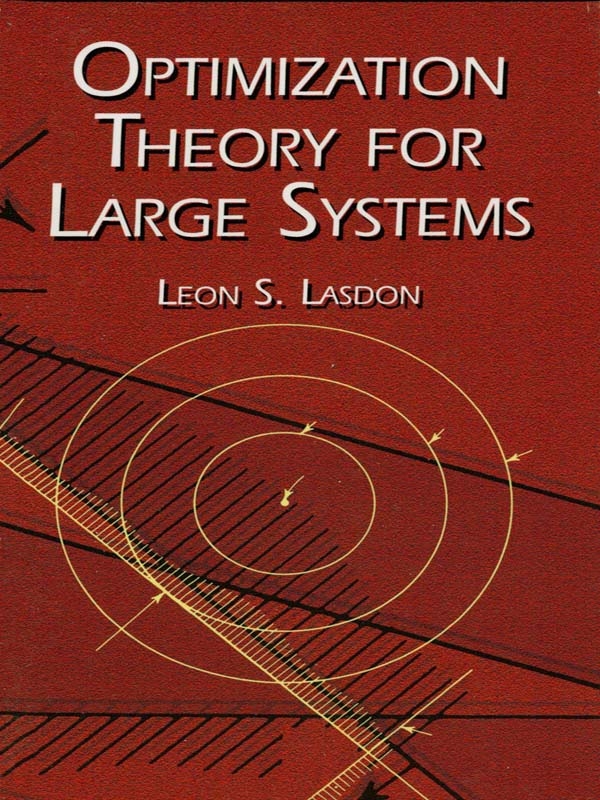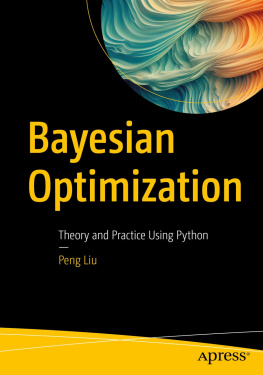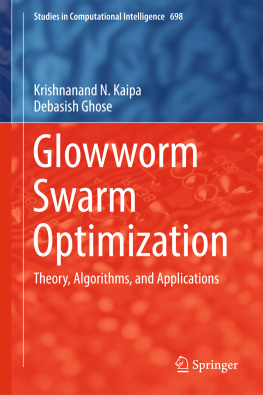Leon S. Lasdon - Optimization Theory for Large Systems.
Here you can read online Leon S. Lasdon - Optimization Theory for Large Systems. full text of the book (entire story) in english for free. Download pdf and epub, get meaning, cover and reviews about this ebook. year: 2013, publisher: Dover Publications, genre: Children. Description of the work, (preface) as well as reviews are available. Best literature library LitArk.com created for fans of good reading and offers a wide selection of genres:
Romance novel
Science fiction
Adventure
Detective
Science
History
Home and family
Prose
Art
Politics
Computer
Non-fiction
Religion
Business
Children
Humor
Choose a favorite category and find really read worthwhile books. Enjoy immersion in the world of imagination, feel the emotions of the characters or learn something new for yourself, make an fascinating discovery.
- Book:Optimization Theory for Large Systems.
- Author:
- Publisher:Dover Publications
- Genre:
- Year:2013
- Rating:4 / 5
- Favourites:Add to favourites
- Your mark:
- 80
- 1
- 2
- 3
- 4
- 5
Optimization Theory for Large Systems.: summary, description and annotation
We offer to read an annotation, description, summary or preface (depends on what the author of the book "Optimization Theory for Large Systems." wrote himself). If you haven't found the necessary information about the book — write in the comments, we will try to find it.
Optimization Theory for Large Systems. — read online for free the complete book (whole text) full work
Below is the text of the book, divided by pages. System saving the place of the last page read, allows you to conveniently read the book "Optimization Theory for Large Systems." online for free, without having to search again every time where you left off. Put a bookmark, and you can go to the page where you finished reading at any time.
Font size:
Interval:
Bookmark:

HANDBOOK OF MATHEMATICAL FUNCTIONS: WITH FORMULAS, GRAPHS, AND MATHEMATICAL TABLES, Edited by Milton Abramowitz and Irene A. Stegun. (0-486-61272-4)
ABSTRACT AND CONCRETE CATEGORIES: THE JOY OF CATS, Jiri Adamek, Horst Herrlich, George E. Strecker. (0-486-46934-4)
NONSTANDARD METHODS IN STOCHASTIC ANALYSIS AND MATHEMATICAL PHYSICS, Sergio Albeverio, Jens Erik Fenstad, Raphael Hegh-Krohn and Tom Lindstrm. (0-486-46899-2)
MATHEMATICS: ITS CONTENT, METHODS AND MEANING, A. D. Aleksandrov, A. N. Kolmogorov, and M. A. Lavrentev. (0-486-40916-3)
COLLEGE GEOMETRY: AN INTRODUCTION TO THE MODERN GEOMETRY OF THE TRIANGLE AND THE CIRCLE, Nathan Altshiller-Court. (0-486-45805-9)
THE WORKS OF ARCHIMEDES, Archimedes. Translated by Sir Thomas Heath. (0-486-42084-1)
REAL VARIABLES WITH BASIC METRIC SPACE TOPOLOGY, Robert B. Ash. (0-486-47220-5)
INTRODUCTION TO DIFFERENTIABLE MANIFOLDS, Louis Auslander and Robert E. MacKenzie. (0-486-47172-1)
PROBLEM SOLVING THROUGH RECREATIONAL MATHEMATICS, Bonnie Averbach and Orin Chein. (0-486-40917-1)
THEORY OF LINEAR OPERATIONS, Stefan Banach. Translated by F. Jellett. (0-486-46983-2)
VECTOR CALCULUS, Peter Baxandall and Hans Liebeck. (0-486-46620-5)
INTRODUCTION TO VECTORS AND TENSORS: SECOND EDITIONTWO VOLUMES BOUND AS ONE, Ray M. Bowen and C.-C. Wang. (0-486-46914-X)
ADVANCED TRIGONOMETRY, C. V. Durell and A. Robson. (0-486-43229-7)
FOURIER ANALYSIS IN SEVERAL COMPLEX VARIABLES, Leon Ehrenpreis. (0-486-44975-0)
THE THIRTEEN BOOKS OF THE ELEMENTS, VOL. 1, Euclid. Edited by Thomas L. Heath. (0-486-60088-2)
THE THIRTEEN BOOKS OF THE ELEMENTS, VOL. 2, Euclid. (0-486-60089-0)
THE THIRTEEN BOOKS OF THE ELEMENTS, VOL. 3, Euclid. Edited by Thomas L. Heath. (0-486-60090-4)
AN INTRODUCTION TO DIFFERENTIAL EQUATIONS AND THEIR APPLICATIONS, Stanley J. Farlow. (0-486-44595-X)
PARTIAL DIFFERENTIAL EQUATIONS FOR SCIENTISTS AND ENGINEERS, Stanley J. Farlow. (0-486-67620-X)
STOCHASTIC DIFFERENTIAL EQUATIONS AND APPLICATIONS, Avner Friedman. (0-486-45359-6)
ADVANCED CALCULUS, Avner Friedman. (0-486-45795-8)
POINT SET TOPOLOGY, Steven A. Gaal. (0-486-47222-1)
DISCOVERING MATHEMATICS: THE ART OF INVESTIGATION, A. Gardiner. (0-486-45299-9)
LATTICE THEORY: FIRST CONCEPTS AND DISTRIBUTIVE LATTICES, George Grtzer. (0-486-47173-X)
ORDINARY DIFFERENTIAL EQUATIONS, Jack K. Hale. (0-486-47211-6)
METHODS OF APPLIED MATHEMATICS, Francis B. Hildebrand. (0-486-67002-3)
BASIC ALGEBRA I: SECOND EDITION, Nathan Jacobson. (0-486-47189-6)
BASIC ALGEBRA II: SECOND EDITION, Nathan Jacobson. (0-486-47187-X)
NUMERICAL SOLUTION OF PARTIAL DIFFERENTIAL EQUATIONS BY THE FINITE ELEMENT METHOD, Claes Johnson. (0-486-46900-X)
ADVANCED EUCLIDEAN GEOMETRY, Roger A. Johnson. (0-486-46237-4)
GEOMETRY AND CONVEXITY: A STUDY IN MATHEMATICAL METHODS, Paul J. Kelly and Max L. Weiss. (0-486-46980-8)
TRIGONOMETRY REFRESHER, A. Albert Klaf. (0-486-44227-6)
CALCULUS: AN INTUITIVE AND PHYSICAL APPROACH (SECOND EDITION), Morris Kline. (0-486-40453-6)
THE PHILOSOPHY OF MATHEMATICS: AN INTRODUCTORY ESSAY, Stephan Krner. (0-486-47185-3)
COMPANION TO CONCRETE MATHEMATICS: MATHEMATICAL TECHNIQUES AND VARIOUS APPLICATIONS, Z. A. Melzak. (0-486-45781-8)
NUMBER SYSTEMS AND THE FOUNDATIONS OF ANALYSIS, Elliott Mendelson. (0-486-45792-3)
EXPERIMENTAL STATISTICS, Mary Gibbons Natrella. (0-486-43937-2)
AN INTRODUCTION TO IDENTIFICATION, J. P. Norton. (0-486-46935-2)
BEYOND GEOMETRY: CLASSIC PAPERS FROM RIEMANN TO EINSTEIN, Edited with an Introduction and Notes by Peter Pesic. (0-486-45350-2)
THE STANFORD MATHEMATICS PROBLEM BOOK: WITH HINTS AND SOLUTIONS, G. Polya and J. Kilpatrick. (0-486-46924-7)
SPLINES AND VARIATIONAL METHODS, P. M. Prenter. (0-486-46902-6)
PROBABILITY THEORY, A. Renyi. (0-486-45867-9)
LOGIC FOR MATHEMATICIANS, J. Barkley Rosser. (0-486-46898-4)
PARTIAL DIFFERENTIAL EQUATIONS: SOURCES AND SOLUTIONS, Arthur David Snider. (0-486-45340-5)
INTRODUCTION TO BIOSTATISTICS: SECOND EDITION, Robert R. Sokal and F. James Rohlf. (0-486-46961-1)
MATHEMATICAL PROGRAMMING, Steven Vajda. (0-486-47213-2)
THE LOGIC OF CHANCE, John Venn. (0-486-45055-4)
THE CONCEPT OF A RIEMANN SURFACE, Hermann Weyl. (0-486-47004-0)
INTRODUCTION TO PROJECTIVE GEOMETRY, C. R. Wylie, Jr. (0-486-46895-X)
FOUNDATIONS OF GEOMETRY, C. R. Wylie, Jr. (0-486-47214-0)
SEE EVERY DOVER BOOK IN PRINT AT WWW.DOVERPUBLICATIONS.COM
Copyright
Copyright 1970, 2002 by Leon S. Lasdon
All rights reserved.
Bibliographical Note
This Dover edition, first published in 2002, is an unabridged republication of the work published by the Macmillan Company, New York, in 1970. A new Preface by the author has been prepared for this edition.
Library of Congress Cataloging-in-Publication Data
Lasdon, Leon S., 1939
Optimization theory for large systems / Leon S. Lasdon.
p. cm.
Originally published: New York : Macmillan, 1970.
Includes bibliographical references and index.
9780486143699
1. Mathematical optimization. 2. Programming (Mathematics)
QA402.5 .L36 2002
519.3dc21
2001042344
Manufactured in the United States by Courier Corporation
41999102
www.doverpublications.com
There are many sections of this book, first published in 1971, which are still valuable today, and some others that have been superseded or bypassed. In this preface, I provide my opinion on how well the various sections have aged, in the hope that it will provide useful guidance for both teachers and researchers. I also attempt to summarize a small but, I hope, important subset of the many and profound new developments in large systems optimization in the last thirty years, and provide some references that I have used in my graduate-level large-scale systems optimization course. I believe that one can construct a useful up-to-date course in this area using the sections of this text indicated in the discussion and table below, the references provided here, and others chosen according to students and professors interests. (For further information on my course, last taught in spring 1997, see www.utexas.edu/courses/lasdon .)
Of the many advances in large systems optimization since 1971, the most profound are the improvements in our ability to solve linear and mixed integer linear programs (LP and MILP). Much of this is due to the incredible improvements in information technology and computing, but a large part is due to advances in LP algorithms and software. In LP, the development of interior point methods (also called barrier methods), starting with the work of Narendra Karmarkar in the mid-1980s, ushered in a period of rapid change. Barrier methods, which do not move through a sequence of adjacent extreme points, created much interest and controversy. Researchers strove to discover alternative derivations and variants of Karmarkars original proposals (Karmarkar 1984), and developed the barrier function framework, which has become dominant today. Lustig, Marsten, and Shanno constructed new barrier method variants, specifically primal-dual algorithms, as well as efficient implementations of these methods (Lustig, Marsten, and Shanno 1994 and Saunders 1994). these codes were able to solve LP instances with hundreds of thousands of constraints and variables, which either could not be solved or took much longer to solve by the simplex codes available at that time. There has been constant progress since then.
Font size:
Interval:
Bookmark:
Similar books «Optimization Theory for Large Systems.»
Look at similar books to Optimization Theory for Large Systems.. We have selected literature similar in name and meaning in the hope of providing readers with more options to find new, interesting, not yet read works.
Discussion, reviews of the book Optimization Theory for Large Systems. and just readers' own opinions. Leave your comments, write what you think about the work, its meaning or the main characters. Specify what exactly you liked and what you didn't like, and why you think so.









